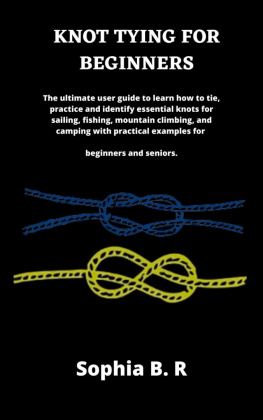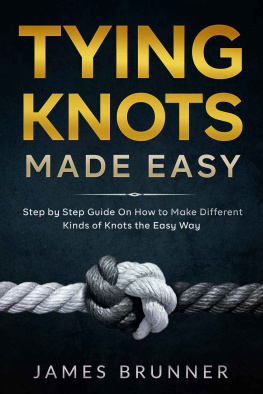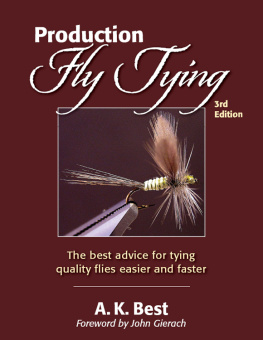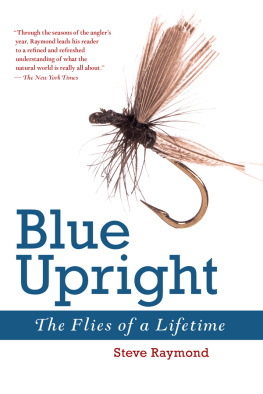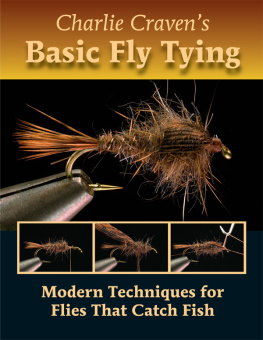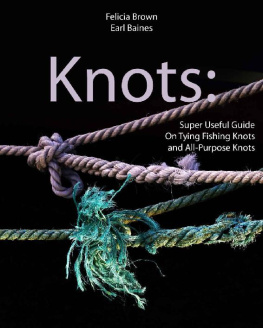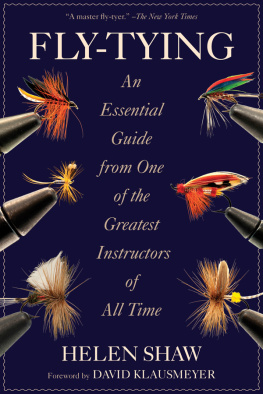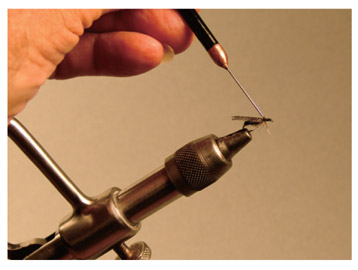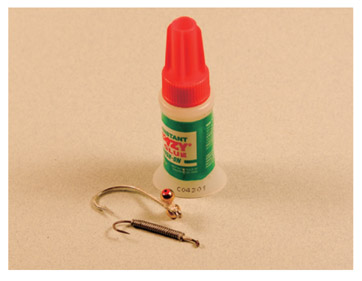ABOUT THE AUTHOR
Jay Fishy Fullum retired in 1995 after a career as a designer to pursue his decades-long passion for writing, tying flies, and fly fishing. In the past twenty years he has designed nearly 150 innovative patterns, many of which are featured in his Creative Tying column in Fly Tyer magazine. He is the author of three books, including Fishys Flies and Fishys Favorites. He lives in Ravena, New York.
CHAPTER 1
KRAZY GLUE
When I began tying flies nearly sixty years ago, I liked to apply a drop of varnish to the head of a fly after tying off the thread. In later years I used a variety of head cements. But now I prefer good old-fashioned Krazy Glue.
_______
I am not totally sure when I began using Krazy Glue, but I believe it was seven or eight years ago. It wasnt an easy transition. I remember that I almost went back to using head cement after having bad experiences with nearly a dozen different brands of superglue. Finally I found a product that came with its own brush and a bottle with a double lip. Ive used Krazy Glue ever since.
This specific brand of superglue is much easier to use than the varnish or head cement, and its incredibly strong. Indeed, its strength is the best reason to use superglue. Once the head of a fly (or any other area) is secured with superglue, the bond is much stronger than when other products are used. Actually, it can sometimes be a little too strong.
On a recent fishing trip to the Farmington River, my wife found that I had used a little too much glue on one of her favorite caddis patterns, filling the eye with glue. She worked for a minute or two trying to clear the eye, and then finally gave up, retiring the pattern to her fly trap. After returning home it took several minutes of poking and prodding for me to finally open up the eye of the hook. Superglue is tough stuff.
THE BEST CHOICE
When I first started trying to use superglue, various brands ended up in the trash after just one or two uses. Soon after the seal was broken, I found that almost all of them required power tools to reopen the bottle; even if I was able to get at the glue inside, I usually found that it had turned into an unusable solid.
Krazy Glue is my favorite brand.
Soon after trying Krazy Glue, I discovered that the double lip on this particular brand prevented the cap from permanently bonding with the bottle. I have opened a new bottle of Krazy Glue, used it while tying several flies, then returned to the vise a week later to find that the cap was easily removed and the glue was still usable.
I seldom recommend a specific product; substitutions can be made when using the vast majority of the materials used when tying flies. But when it comes to superglue, I strongly suggest that you save yourself all aggravation associated with most of the other products and stick with Krazy Glue.
Krazy Glue comes with its own brush, making it very tier friendly when applying it to specific areas of a fly or securing a variety of materials directly to a hook. Be careful, though; applying too much Krazy Glue can ruin a fly. It takes a couple of minutes for superglue to dry. If you apply too much, the glue has time to soak into unwanted areas where it hardens, turning the pattern into a rock. When tying small flies, Ive found that removing some of the bristles from the brush makes it better for smaller creations. Still, it is easier and safer to use a superglue bodkin when applying glue to flies #16 or smaller.
A double lip prevents the cap from permanently attaching itself to the bottle.
A superglue bodkin is simply a small bodkin made with a very fine sewing needle. Glue a needle into any small handle. Use whatever is available. When applying superglue to small flies, deposit a tiny amount of glue from the brush to the tip of the bodkin, and then transfer the glue from the bodkin to the fly. Using the small bodkin makes it possible to control the exact amount of superglue that is applied. This method is also handy when attempting to place a tiny drop of glue on a very specific area of a fly.
The brush works well when tying larger flies.
KEEPING YOUR BODKIN CLEAN
Dried superglue and paints can quickly accumulate on your bodkin. And while scraping off the residue with the sharp edge of a knife or wiping the bodkin with a cloth every time it is used will keep it clean, I prefer to occasionally use my homemade bodkin cleaner. Find an old ballpoint pen, the type with the button on the end that retracts the tip, and take it apart, saving the front portion of the plastic body. Fill the inside of the plastic body about three-quarters of the way full with fine steel wool. When the bodkin needs cleaning, push the needle into the steel wool a couple of times. Youll find that the glue or paint residue is quickly removed.
A small bodkin does a better job than the brush when tying smaller flies.
This simple tool will clean a bodkin in seconds.
I USE IT OFTEN
There are many ways a fly tier can use Krazy Glue, some more important than others, but using it when attempting to secure metal to metal is a must. If you wrap a layer of lead wire around the shank of the hook and then complete a given pattern without gluing the wire, the fly will not be very strong. But if you wrap a layer of thread onto the hook shank, wrap the lead wire over it, then coat the wire with Krazy Glue, the base of your fly will be much stronger and less apt to twist on the hook. Glue applied to the thread wraps after attaching lead wire, dumbbell, or bead-chain eyes will prevent them from twisting. Just remember: After tying anything made out of metal onto a hook, the next step should be to apply the glue.
After wrapping lead wire or attaching metal eyes, reach for the Krazy Glue.
MAKE THE FLY MORE DURABLE
I like to brush a thin coat of Krazy Glue over stripped herl, tinsel, and quill bodies on many of my flies. The glue greatly improves the durability of these normally fragile bodies. If a portion of any fly is easily broken, consider a thin coat of glue to strengthen it. I wouldnt recommend brushing the glue onto fuzzy materials, though; doing so would ruin the quality of the material. Applying glue to peacock herl, for example, would obviously ruin the appearance of the herl. But if you apply the superglue to the area where you intend to wrap the herl before wrapping the body, the finished fly will be much stronger.
Soon after attaching the thread, I generally reach for the superglue. If the base for all of the remaining steps is not secured to the hook shank, the fly will be a lot less durable. When tying I also use a little glue between steps. The downside of this habit is that on more than one occasion I have wrapped a bunch of stuff around a hook, glued it, then decided I needed to start over, or at least reuse the hook. Trying to remove the materials from a hook shank requires some effort when Krazy Glue has been used between steps. Someday Ill learn to minimize the use of superglue when attempting to establish a new creation.


